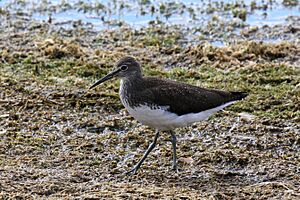Green sandpiper facts for kids
The green sandpiper (Tringa ochropus) is a small bird that loves to live near water. It's often called a wader or shorebird because it walks in shallow water to find its food. These birds are found in many parts of the world, especially across Europe and Asia.
The green sandpiper is related to the solitary sandpiper (T. solitaria). Both of these birds have brown wings with small light spots. They also have a soft but clear pattern on their neck and chest. What's really special is that both species build their nests in trees. Most other birds in their family, called scolopacids, nest on the ground.
Sometimes, green sandpipers have even been seen mixing with common sandpipers. This means they can sometimes have babies together, even though they are from slightly different groups of birds.
Quick facts for kids Green sandpiper |
|
|---|---|
 |
|
| At Standlake, Oxfordshire | |
| Conservation status | |
| Scientific classification | |
| Genus: |
Tringa
|
| Species: |
ochropus
|
 |
|
| Where the Green Sandpiper lives Breeding Passage Non-breeding | |
Contents
About the Green Sandpiper's Name
Every living thing has a scientific name, which helps scientists around the world know exactly which animal they are talking about. The green sandpiper's scientific name is Tringa ochropus.
This name was given by a Swedish scientist named Carl Linnaeus in 1758. The word Tringa comes from an old name for a wading bird. The word ochropus comes from two ancient Greek words: okhros, meaning "ochre" (a yellowish-brown color), and pous, meaning "foot." So, its name basically means "yellow-footed wader."
What Does a Green Sandpiper Look Like?
The green sandpiper is a somewhat plump bird. It has a dark greenish-brown back and wings. Its head and chest are grayish, and the rest of its underside is white.
The back of the bird has white spots. These spots are most noticeable when the bird is breeding. They are less visible in winter or on young birds. Both its legs and its short beak are dark green.
When the green sandpiper flies, it looks very striking. Its wings are dark both above and below. It also has a bright white patch on its rump (the area above its tail). This white patch helps you tell it apart from the solitary sandpiper, which looks similar but is a bit smaller.
When it flies, the green sandpiper makes a special three-note whistle sound. This sound can help you identify it.
Where Green Sandpipers Live and Travel
Green sandpipers breed in the cooler, northern parts of Europe and across Asia. They are migratory birds, which means they travel long distances.
When winter comes, they fly south to warmer places. They spend their winters in southern Europe, parts of India, Southeast Asia, and tropical Africa. They find their food, which is small insects and other tiny creatures, by picking them out of the mud around ponds.
These birds usually don't gather in large groups. You might see a few of them together in good feeding spots, but they are not very social. Green sandpipers prefer freshwater areas, like small ponds or the edges of rivers. They often choose places that are too small or hidden for other wading birds.
Green Sandpiper Reproduction and Life Cycle
Green sandpipers lay their eggs in old nests that other birds have left behind. They often use nests built by birds like the fieldfare (Turdus pilaris).
A female green sandpiper usually lays between two and four eggs. It takes about three weeks for these eggs to hatch.
Green Sandpiper Status
The green sandpiper is found in many places and is not rare. Because of this, the IUCN (International Union for Conservation of Nature) does not consider it a threatened species globally.
This bird is also protected by an agreement called the Agreement on the Conservation of African-Eurasian Migratory Waterbirds (AEWA). This agreement helps protect birds that migrate across Africa and Eurasia.
Gallery
-
Wintering adult near Hodal, Faridabad district, Haryana, India





